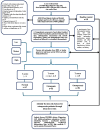The Extensive Study of Magnesium Deficiency, 25-(OH) Vitamin D3, Inflammatory Markers, and Parathyroid Hormone in Relation to Bone Mineral Density in Iraqi Osteoporosis Patients: A Cross-Sectional Study
- PMID: 40213265
- PMCID: PMC11982515
- DOI: 10.1002/hsr2.70641
The Extensive Study of Magnesium Deficiency, 25-(OH) Vitamin D3, Inflammatory Markers, and Parathyroid Hormone in Relation to Bone Mineral Density in Iraqi Osteoporosis Patients: A Cross-Sectional Study
Abstract
Backgrounds and aims: Magnesium is essential for bone development and mineralization and may influence osteoporosis progression. However, its relationship with low bone mineral density (BMD) and fracture risk is not well understood. This study aimed to identify the primary risk factors and the effect of magnesium deficiency on bone density in osteoporosis patients.
Methods: The study involved 162 adults categorized into normal, osteopenia, and osteoporosis groups, plus 50 healthy individuals. BMD of the lumbar spine (L1-L4) and femur neck, body mass index, and T-scores were assessed via dual-energy X-ray absorptiometry, while serum magnesium, 25-(OH) Vitamin D3, inflammatory markers, and other clinical tests were measured. The results showed significant variations in BMD, T-scores, magnesium, and vitamin 25(OH)D levels.
Results: Notably, osteoporosis patients exhibited a substantial decline in mean BMD along with an increase in mean T-scores. They also had significantly lower serum levels of magnesium, vitamin 25(OH)D, and calcium, compared to other groups, while parathyroid hormone levels slightly increased. Inflammatory markers were significantly elevated in osteoporosis patients. Magnesium and vitamin 25(OH)D showed an inverse relationship with T-scores and a direct positive correlation with BMD and bone mineral content. Additionally, a negative correlation between magnesium and inflammatory markers was observed. The findings highlighted a strong correlation between magnesium deficiency and osteoporosis, with a more significant odds ratio compared to factors like 25(OH)D, PTH, BMD, T-score, and calcium.
Conclusion: Magnesium deficiency has a more pronounced impact on bone health than vitamin D deficiency. Thus, magnesium deficiency emerges as a major risk factor for osteoporosis progression and a predictor of fracture incidence in patients with osteoporosis or osteopenia.
Keywords: bone mineral density; magnesium; osteoporosis; risk factor; vitamin 25(OH)D.
© 2025 The Author(s). Health Science Reports published by Wiley Periodicals LLC.
Conflict of interest statement
The authors declare no conflicts of interest.
Figures
Similar articles
-
Vitamin D status and its associations with bone mineral density, bone turnover markers, and parathyroid hormone in Chinese postmenopausal women with osteopenia and osteoporosis.Front Nutr. 2024 Jan 10;10:1307896. doi: 10.3389/fnut.2023.1307896. eCollection 2023. Front Nutr. 2024. PMID: 38268673 Free PMC article.
-
Reduced spinal bone mineral density in adolescents of an Ultra-Orthodox Jewish community in Brooklyn.Pediatrics. 2001 May;107(5):E79. doi: 10.1542/peds.107.5.e79. Pediatrics. 2001. PMID: 11331729
-
Correlation of vitamin D, bone mineral density and parathyroid hormone levels in adults with low bone density.Indian J Orthop. 2013 Jul;47(4):402-7. doi: 10.4103/0019-5413.114932. Indian J Orthop. 2013. PMID: 23960286 Free PMC article.
-
High prevalence of vitamin D deficiency among healthy Saudi Arabian men: relationship to bone mineral density, parathyroid hormone, bone turnover markers, and lifestyle factors.Osteoporos Int. 2012 Feb;23(2):675-86. doi: 10.1007/s00198-011-1606-1. Epub 2011 Apr 6. Osteoporos Int. 2012. PMID: 21625888
-
The role of vitamin D in maintaining bone health in older people.Ther Adv Musculoskelet Dis. 2017 Apr;9(4):89-95. doi: 10.1177/1759720X17692502. Epub 2017 Feb 14. Ther Adv Musculoskelet Dis. 2017. PMID: 28382112 Free PMC article. Review.
References
-
- Jones G., Nguyen T., Sambrook P. N., Kelly P. J., Gilbert C., and Eisman J. A., “Symptomatic Fracture Incidence in Elderly Men and Women: The Dubbo Osteoporosis Epidemiology Study (DOES),” Osteoporosis International 4 (1994): 277–282. - PubMed
-
- Lukert B., Higgins J., and Stoskopf M., “Menopausal Bone Loss Is Partially Regulated by Dietary Intake of Vitamin D,” Calcified Tissue International 51 (1992): 173–179. - PubMed
-
- Sahota O., “Osteoporosis and the Role of Vitamin D and Calcium‐Vitamin D Deficiency, Vitamin D Insufficiency and Vitamin D Sufficiency,” Age and Ageing 29 (2000): 301–304. - PubMed
LinkOut - more resources
Full Text Sources


